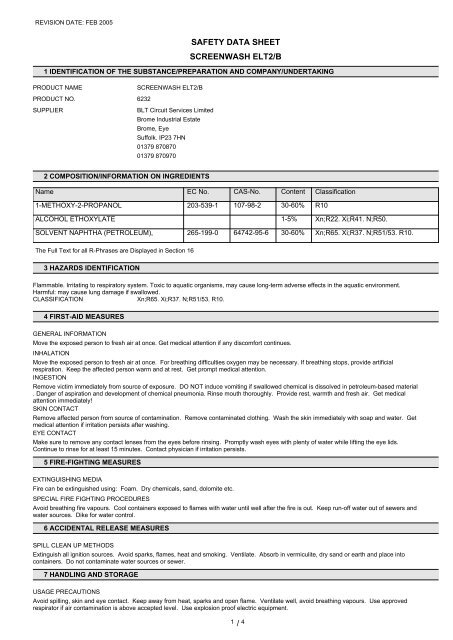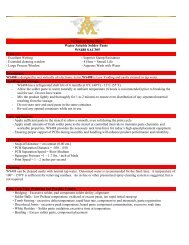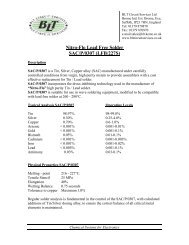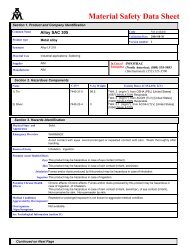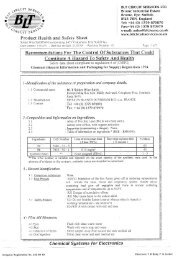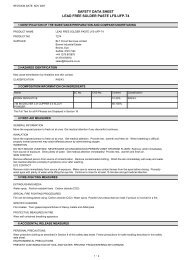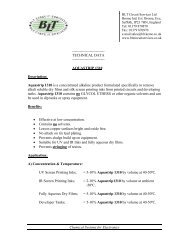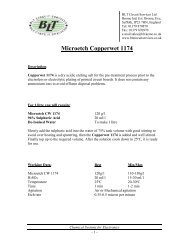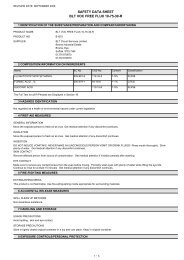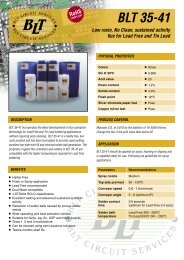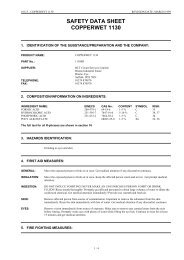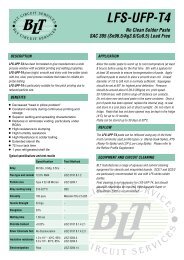ELT2B H&S.pdf - BLT Circuit Services
ELT2B H&S.pdf - BLT Circuit Services
ELT2B H&S.pdf - BLT Circuit Services
Create successful ePaper yourself
Turn your PDF publications into a flip-book with our unique Google optimized e-Paper software.
REVISION DATE: FEB 2005<br />
SAFETY DATA SHEET<br />
SCREENWASH ELT2/B<br />
1 IDENTIFICATION OF THE SUBSTANCE/PREPARATION AND COMPANY/UNDERTAKING<br />
PRODUCT NAME<br />
SCREENWASH ELT2/B<br />
PRODUCT NO. 6232<br />
SUPPLIER<br />
<strong>BLT</strong> <strong>Circuit</strong> <strong>Services</strong> Limited<br />
Brome Industrial Estate<br />
Brome, Eye<br />
Suffolk. IP23 7HN<br />
01379 870870<br />
01379 870970<br />
2 COMPOSITION/INFORMATION ON INGREDIENTS<br />
Name EC No. CAS-No. Content Classification<br />
1-METHOXY-2-PROPANOL 203-539-1 107-98-2 30-60% R10<br />
ALCOHOL ETHOXYLATE 1-5% Xn;R22. Xi;R41. N;R50.<br />
SOLVENT NAPHTHA (PETROLEUM), 265-199-0 64742-95-6 30-60% Xn;R65. Xi;R37. N;R51/53. R10.<br />
The Full Text for all R-Phrases are Displayed in Section 16<br />
3 HAZARDS IDENTIFICATION<br />
Flammable. Irritating to respiratory system. Toxic to aquatic organisms, may cause long-term adverse effects in the aquatic environment.<br />
Harmful: may cause lung damage if swallowed.<br />
CLASSIFICATION Xn;R65. Xi;R37. N;R51/53. R10.<br />
4 FIRST-AID MEASURES<br />
GENERAL INFORMATION<br />
Move the exposed person to fresh air at once. Get medical attention if any discomfort continues.<br />
INHALATION<br />
Move the exposed person to fresh air at once. For breathing difficulties oxygen may be necessary. If breathing stops, provide artificial<br />
respiration. Keep the affected person warm and at rest. Get prompt medical attention.<br />
INGESTION<br />
Remove victim immediately from source of exposure. DO NOT induce vomiting if swallowed chemical is dissolved in petroleum-based material<br />
. Danger of aspiration and development of chemical pneumonia. Rinse mouth thoroughly. Provide rest, warmth and fresh air. Get medical<br />
attention immediately!<br />
SKIN CONTACT<br />
Remove affected person from source of contamination. Remove contaminated clothing. Wash the skin immediately with soap and water. Get<br />
medical attention if irritation persists after washing.<br />
EYE CONTACT<br />
Make sure to remove any contact lenses from the eyes before rinsing. Promptly wash eyes with plenty of water while lifting the eye lids.<br />
Continue to rinse for at least 15 minutes. Contact physician if irritation persists.<br />
5 FIRE-FIGHTING MEASURES<br />
EXTINGUISHING MEDIA<br />
Fire can be extinguished using: Foam. Dry chemicals, sand, dolomite etc.<br />
SPECIAL FIRE FIGHTING PROCEDURES<br />
Avoid breathing fire vapours. Cool containers exposed to flames with water until well after the fire is out. Keep run-off water out of sewers and<br />
water sources. Dike for water control.<br />
6 ACCIDENTAL RELEASE MEASURES<br />
SPILL CLEAN UP METHODS<br />
Extinguish all ignition sources. Avoid sparks, flames, heat and smoking. Ventilate. Absorb in vermiculite, dry sand or earth and place into<br />
containers. Do not contaminate water sources or sewer.<br />
7 HANDLING AND STORAGE<br />
USAGE PRECAUTIONS<br />
Avoid spilling, skin and eye contact. Keep away from heat, sparks and open flame. Ventilate well, avoid breathing vapours. Use approved<br />
respirator if air contamination is above accepted level. Use explosion proof electric equipment.<br />
1 / 4
REVISION DATE: FEB 2005<br />
STORAGE CLASS<br />
Flammable liquid storage.<br />
SCREENWASH ELT2/B<br />
8 EXPOSURE CONTROLS/PERSONAL PROTECTION<br />
Name<br />
1-METHOXY-2-PROPANOL<br />
Std<br />
LT - ppm LT - mg/m3 ST - ppm ST - mg/m3<br />
OES 100 ppm(Sk) 375 mg/m3(Sk) 150 ppm(Sk) 560 mg/m3(Sk)<br />
INGREDIENT COMMENTS<br />
OES = Occupational Exposure Standard.<br />
PROTECTIVE EQUIPMENT<br />
ENGINEERING MEASURES<br />
Provide adequate general and local exhaust ventilation.<br />
RESPIRATORY EQUIPMENT<br />
Respiratory protection must be used if air contamination exceeds acceptable level.<br />
HAND PROTECTION<br />
Use protective gloves.<br />
EYE PROTECTION<br />
Use approved safety goggles or face shield.<br />
OTHER PROTECTION<br />
Wear appropriate clothing to prevent any possibility of liquid contact and repeated or prolonged vapour contact.<br />
HYGIENE MEASURES<br />
DO NOT SMOKE IN WORK AREA! Wash at the end of each work shift and before eating, smoking and using the toilet. Wash promptly with<br />
soap & water if skin becomes contaminated. Promptly remove any clothing that becomes contaminated. Use appropriate skin cream to<br />
prevent drying of skin. When using do not eat, drink or smoke.<br />
9 PHYSICAL AND CHEMICAL PROPERTIES<br />
APPEARANCE<br />
COLOUR<br />
ODOUR<br />
SOLUBILITY<br />
Clear Liquid<br />
Light (or pale) Yellow<br />
Hydrocarbon<br />
Slightly soluble in water. Soluble in Organic solvents.<br />
RELATIVE DENSITY ~ 0.90 @ 20 °c FLASH POINT (°C) 32 CC (Closed cup).<br />
10 STABILITY AND REACTIVITY<br />
STABILITY<br />
Stable under normal temperature conditions.<br />
CONDITIONS TO AVOID<br />
Avoid heat. Avoid contact with oxidisers or reducing agents.<br />
HAZARDOUS DECOMPOSITION PRODUCTS<br />
Fire creates: Vapours/gases/fumes of: Carbon monoxide (CO). Carbon dioxide (CO2).<br />
11 TOXICOLOGICAL INFORMATION<br />
HEALTH WARNINGS<br />
INHALATION. May cause irritation to the respiratory system. Solvent vapours are hazardous and may cause nausea, sickness and headaches<br />
. SKIN CONTACT. Irritating to skin. Product has a defatting effect on skin. EYE CONTACT. Irritating to eyes. INGESTION. May cause<br />
discomfort.<br />
12 ECOLOGICAL INFORMATION<br />
ECOTOXICITY<br />
Dangerous for the environment if discharged into watercourses.<br />
13 DISPOSAL CONSIDERATIONS<br />
2 / 4
REVISION DATE: FEB 2005<br />
DISPOSAL METHODS<br />
SCREENWASH ELT2/B<br />
Dispose of waste and residues in accordance with local authority requirements.<br />
14 TRANSPORT INFORMATION<br />
PROPER SHIPPING NAME<br />
FLAMMABLE LIQUID, NOS (Contains 1-Methoxy-2-Propanol and Solvent Naptha)<br />
UN NO. ROAD 0<br />
ADR CLASS NO.<br />
3<br />
ADR CLASS<br />
Class 3: Flammable liquids.<br />
ADR PACK GROUP<br />
HAZARD No. (ADR) 33<br />
ADR LABEL NO.<br />
3<br />
HAZCHEM CODE<br />
RID CLASS NO.<br />
3[Y]E<br />
3<br />
CEFIC TEC(R) NO.<br />
RID PACK GROUP<br />
UN NO. SEA 1993<br />
IMDG CLASS<br />
3.2<br />
IMDG PAGE NO.<br />
EMS<br />
3230<br />
3-07<br />
IMDG PACK GR.<br />
MFAG<br />
UN NO. AIR 1993<br />
ICAO CLASS<br />
3<br />
AIR PACK GR.<br />
15 REGULATORY INFORMATION<br />
II<br />
PACKING GROUP III<br />
30G30<br />
3(b)<br />
II<br />
See Sub Sec. 4.2 of MFAG<br />
LABELLING<br />
CONTAINS<br />
RISK PHRASES<br />
SAFETY PHRASES<br />
Harmful<br />
Dangerous for the<br />
environment<br />
SOLVENT NAPHTHA (PETROLEUM),<br />
R10<br />
R37<br />
Flammable.<br />
Irritating to respiratory system.<br />
R51/53 Toxic to aquatic organisms, may cause long-term adverse effects in the aquatic environment<br />
.<br />
R65<br />
Harmful: may cause lung damage if swallowed.<br />
S51<br />
S57<br />
S60<br />
S61<br />
S62<br />
Use only in well-ventilated areas.<br />
Use appropriate container to avoid environmental contamination.<br />
This material and its container must be disposed of as hazardous waste.<br />
Avoid release to the environment. Refer to special instructions/safety data sheets.<br />
If swallowed, do not induce vomiting: seek medical advice immediately and show this<br />
container or label.<br />
16 OTHER INFORMATION<br />
REVISION DATE FEB 2005<br />
REV. NO./REPL. SDS GENERATED 3<br />
SDS NO.<br />
ELT/16/3<br />
3 / 4
REVISION DATE: FEB 2005<br />
RISK PHRASES IN FULL<br />
R10<br />
R22<br />
R37<br />
R41<br />
R50<br />
R51/53<br />
R65<br />
SCREENWASH ELT2/B<br />
Flammable.<br />
Harmful if swallowed.<br />
Irritating to respiratory system.<br />
Risk of serious damage to eyes.<br />
Very toxic to aquatic organisms.<br />
Toxic to aquatic organisms, may cause long-term adverse effects in the aquatic environment.<br />
Harmful: may cause lung damage if swallowed.<br />
4 / 4


